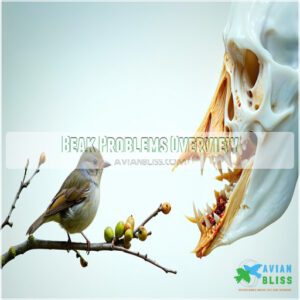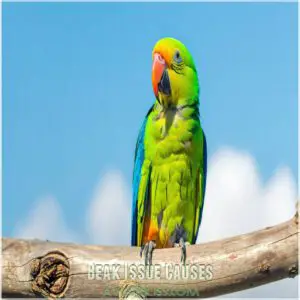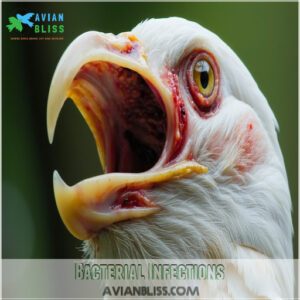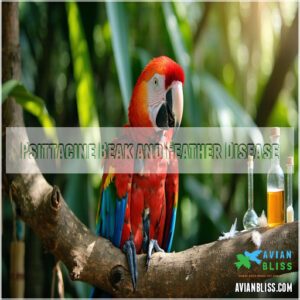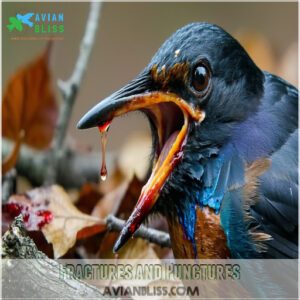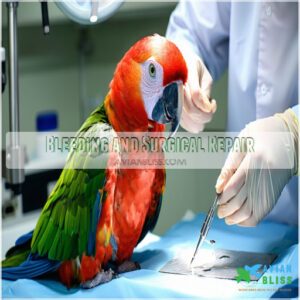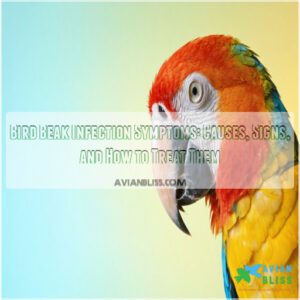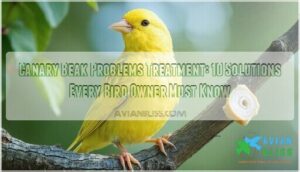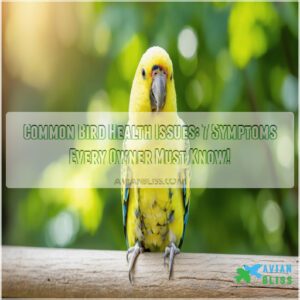This site is supported by our readers. We may earn a commission, at no cost to you, if you purchase through links.

Common beak problems in birds include overgrowth, softening, and infections that can turn their perfect peckers into troublesome tools.
You’ll notice signs like holes, peeling, or unusual discoloration – think of it as your bird’s way of waving a red flag.
These issues often stem from poor nutrition, lack of exercise, or underlying health conditions.
Just like your fingernails need care, your bird’s beak requires proper maintenance.
With the right knowledge and preventive measures, you can keep that beautiful beak in tip-top shape.
The solutions might surprise you.
Table Of Contents
- Key Takeaways
- Beak Problems Overview
- Beak Issue Causes
- Beak Infections and Diseases
- Beak Injury and Trauma
- Preventing Beak Problems
- Frequently Asked Questions (FAQs)
- Are beak problems common in pet birds?
- What are common beak problems?
- How do health problems affect a bird’s beak?
- What causes overgrown beaks in birds?
- Can a bird have an overgrown beak?
- Why does my bird have a broken beak?
- What does an unhealthy bird’s beak look like?
- What’s wrong with my bird’s beak?
- What is the bird beak syndrome?
- What disease has a bird’s beak appearance?
- Conclusion
Key Takeaways
- You’ll want to watch out for warning signs like beak discoloration, peeling, or unusual texture changes, as these can signal serious underlying health issues that need immediate veterinary attention.
- Your bird’s diet plays a crucial role in beak health – nutritional deficiencies can lead to softening, overgrowth, or weakness, so you’ll need to provide a balanced diet rich in vitamins and minerals.
- Regular veterinary checkups are essential, since birds often hide illness and beak problems can quickly escalate from minor issues to serious health concerns if left untreated.
- You’ll need to create a safe, clean environment for your bird, including proper cage maintenance, avoiding chemical exposures, and providing opportunities for natural beak wear and exercise.
Beak Problems Overview
Beak problems in birds range from overgrowth and discoloration to cracks and deformities, each affecting their ability to eat and function.
Understanding these issues is essential for identifying symptoms early and ensuring proper care.
Holes or Pitting in Beak
Holes or pitting in a bird’s beak can signal underlying beak problems.
Common pitting causes include infections, nutritional deficiencies, or trauma.
Here’s what to watch for and discuss with your vet:
- Check for infections or injuries.
- Maintain proper parrot beak care.
- Use supplements for diet gaps.
- Explore hole repair options.
- Consider professional beak reshaping or filling.
Peeling or Flaking of Beak
Peeling or flaking of the beak often signals bird beak issues tied to keratin shedding.
Causes include poor nutrition, dehydration, or over-climbing on abrasive surfaces.
Peeling symptoms range from slight flaking to noticeable layers peeling away.
Parrot beak care involves boosting beak health through a diet rich in vitamins and minerals, plus proper grooming for effective beak restoration and long-lasting health.
Discoloration of Beak
If you’ve noticed beak discoloration, like unexpected color changes, pigment loss, or beak staining, it’s worth paying attention.
Discolored beaks can signal issues ranging from fungal spots to nutritional deficiencies affecting bird beak health.
Sometimes, beak bleaching occurs from excessive sun exposure or illness.
These beak problems symptoms shouldn’t be ignored—early intervention can prevent complications and restore your bird’s vibrant beak color.
Softening of Beak Material
Softened beaks can signal underlying issues with beak keratin or mineral deficiencies, like low calcium levels.
When the beak texture changes, becoming unusually soft, it compromises beak density and functionality.
Beak softening often arises from poor diet or infections.
Prioritize avian beak care with proper nutrition, balanced minerals, and regular vet visits to prevent ongoing beak problems and guarantee overall beak health.
Regular checks for beak health issues can help identify problems early on, allowing for timely intervention and treatment.
Beak Issue Causes
Beak problems in birds often stem from a combination of poor nutrition, limited exercise, underlying health issues, or genetic factors.
Understanding these causes can help you address potential risks and keep your bird healthy.
Beak problems can be prevented by being aware of the causes and taking necessary precautions.
Poor Diet and Nutrition
Malnutrition effects, like a poor diet or dietary imbalance, can wreak havoc on a bird’s beak.
Nutrient deficiencies, such as vitamin A deficiency, lead to white plaques, while calcium deficiency may result in flaky or weak beaks.
A diet lacking vitamin D hampers nutrient absorption, leaving the beak soft or rubbery.
Balance the menu to prevent these issues.
Understanding beak health problems is essential for maintaining a bird’s overall well-being.
Insufficient Exercise and Space
Lack of exercise and cramped cages can lead to bird health issues like beak problems.
Birds need space to move, stretch, and exercise.
Here’s how to help:
- Choose a cage size suited for flying and activity.
- Provide toys for environmental enrichment.
- Encourage out-of-cage time daily.
- Monitor for environmental hazards.
- Meet your bird’s exercise needs to maintain strength and vigor.
Regular health checks can help identify beak health issues early on, ensuring prompt treatment and prevention of further complications.
Underlying Health Conditions
Underlying health conditions like respiratory issues, liver disease, or kidney stones can directly affect bird beak health, leading to deformities or beak problems.
For instance, heart problems or chronic allergies might weaken overall immunity, increasing risks of beak disease.
Stay alert to unusual signs and consult a vet promptly to address these hidden culprits behind your bird’s beak concerns.
Genetic Predisposition
Inherited traits can play a surprising role in your bird’s beak health.
Some breeds are prone to genetic problems like scissor beak or crossed beak.
Here’s how a genetic predisposition might show up:
- Genetic Mutations: Faulty DNA causes structural beak deformities.
- Inherited Disorders: Undetected breed-specific defects.
- DNA Testing: Identifies issues before problems worsen.
Stay informed for healthier birds!
Beak Infections and Diseases
When a bird’s beak is damaged by infections or diseases, it can lead to serious health issues that affect their ability to eat and function.
Understanding common culprits like bacterial, fungal, and viral infections can help you catch problems early and guarantee proper care.
Bacterial Infections
Bacterial infections in a bird’s beak can lead to painful lesions or deformities.
Watch for appetite loss, listlessness, or breathing trouble. A bacterial swab helps confirm a diagnosis, with antibiotics like azithromycin restoring health.
Infection control is vital—clean cages and proper hygiene help prevent issues. Avian medicine guarantees quick recovery from beak bacterial infections with timely care.
Beak problems can be caused by beak growth issues that require immediate attention.
| Symptom | Cause | Treatment |
|---|---|---|
| Beak Lesions | Bacterial Infection | Antibiotic Treatment |
| Weight Loss | Staphylococci/Streptococci | Avian Medicine |
| Breathing Trouble | Lung Infections | Doxycycline |
| Nasal Discharge | Infection Spread | Infection Control |
| Listlessness | Beak Infection | Timely Diagnosis |
The table outlines the symptoms, causes, and treatments for various beak-related issues in birds, emphasizing the importance of infection control and proper hygiene.
Fungal Infections
Fungal infections, like avian mycosis, often wreak havoc on your bird’s beak, causing beak lesions and discomfort. Candida infections are common culprits, leading to whitish plaques and beak fungal disease.
- Monitor for white or yellow patches.
- Promote immune health to combat fungal spores.
- Optimize hygiene to prevent beak infections.
- Provide vet-approved antifungal treatments.
- Avoid damp, unsanitary environments worsening fungal lesions.
Viral Infections
Viral infections like avian herpes or poxvirus can cause painful beak lesions and other symptoms in birds.
These viruses spread through direct contact or viral shedding.
Watch for changes in your bird’s beak health.
Proper care and hygiene help prevent these issues.
Understanding psittacine beak disease is essential for identifying symptoms and taking preventive measures.
| Virus | Symptoms |
|---|---|
| Avian Herpes | Beak lesions, swelling |
| Poxvirus | Scabs, beak ulcers |
| PBFD (Circovirus) | Beak deformities |
| Beak Infection | Cracking, discoloration |
| Viral Shedding | Contagion risk |
Psittacine Beak and Feather Disease
PBFD, or Psittacine Beak and Feather Disease, is a viral beak infection causing severe beak deformity, feather loss, and even necrosis.
With a high viral load, it spreads through disease transmission like contaminated surfaces or infected birds.
Diagnostic tests confirm PBFD early, as it’s fatal, and regular checkups are essential to protect your bird.
Over 78 parrot species globally are impacted by PBFD, making it crucial to take preventive measures.
Beak Injury and Trauma
Beak injuries in birds can happen quickly, often caused by falls, fights, or accidents with hard surfaces.
These injuries, including fractures or detachment, are serious and require immediate veterinary care to prevent lasting damage, which is a critical aspect of veterinary care.
Fractures and Punctures
Fractures and punctures in a bird’s beak are serious and need quick care.
Consider an avian beak splint for stabilization.
Beak injuries might cause pain, eating issues, or even infections.
Here’s what to watch for:
- Beak cracks or splits – visible line fractures.
- Deep puncture wounds – sharp object injuries.
- Bleeding or swelling – signs of trauma.
- Eating or grooming difficulty – hinting at deeper damage.
Avulsions and Beak Detachment
Beak avulsions, where the keratin layer tears or detaches, are serious avian beak problems often caused by fights, collisions, or predators.
Immediate care, like cleaning and avulsion surgery within 24 hours, dramatically improves survival chances.
Without timely beak reattachment, complications like infections or granulation tissue can arise.
Preventing beak trauma requires safe environments and addressing detachment causes early.
Bleeding and Surgical Repair
When beak bleeding occurs, you need quick action.
Applying pressure can help clot blood, but severe cases might demand surgical repair.
Veterinarians use avian anesthesia for delicate beak surgeries, ensuring precision for beak reconstruction and wound healing.
- Apply clotting powder or cornstarch for minor bleeds.
- Seek surgery for complex beak fractures or repairs.
- Monitor for post-surgical infection signs.
Beak Prosthetics and Feeding Assistance
When severe injuries or deformities hinder a bird’s ability to eat, beak prosthetics can restore functionality.
Made from durable prosthetic materials, these assistive devices help birds regain independence.
Feeding aids and adaptive eating tools may also support birds during recovery.
Skilled vets custom-fit these Beak Replacements, ensuring comfort and effectiveness, offering hope for birds requiring beak repair or bird feeding assistance.
The use of beak prosthetics involves understanding beak repair options to make informed decisions about a bird’s care.
Preventing Beak Problems
You can prevent beak problems by focusing on your bird’s overall health through proper nutrition, regular grooming, and a safe, clean environment.
Routine veterinary checkups are essential to identify and address any potential issues early, which is a key part of overall health.
Proper Nutrition and Diet
To protect your feathered friend’s beak after an injury, you’ll want to focus on proper nutrition.
A well-balanced diet prevents soft, overgrown beaks and those pesky flaking issues.
Mix pellet foods with fresh fruits, and don’t rely just on seeds – they’re linked to fatty liver disease and beak problems.
Add calcium and vitamin D supplements as needed, especially for finches and budgies prone to nutritional deficiencies.
Providing a high quality bird seed mix can also support overall beak health.
This approach ensures your bird receives a balanced diet.
Regular Beak Trimming
Your bird’s healthy beak needs proper shaping to prevent problems down the line.
Professional trimming is far more complex than a simple nail trim—it requires expertise to maintain the right shape and length.
Here’s what you need for proper beak shaping:
- Professional veterinary assessment
- Specialized trimming tools for birds
- Understanding of your bird’s natural beak shape
- Regular monitoring for overgrowth signs
Proper beak care involves addressing beak health issues to guarantee your bird’s overall well-being.
Remember, beak trimming isn’t a DIY task—it requires a skilled avian vet to avoid pain or eating difficulties.
Safe Environment and Hygiene
Just like you, your feathered friends need a pristine living space.
Here’s what you’ll need for ideal cage maintenance and beak health:
| Task | Frequency | Products |
|---|---|---|
| Remove Droppings | Daily | Paper towels, cage wipes |
| Change Water | Twice Daily | Fresh containers, filters |
| Sanitize Dishes | Weekly | Bird-safe disinfectant |
| Deep Clean Cage | Monthly | Scrub brush, non-toxic cleaners |
Place your bird in a separate room during cleaning to avoid chemical exposure.
Using bird-safe disinfectants and maintaining proper air quality helps prevent beak infections and supports natural beak maintenance behaviors.
Regular Veterinary Checkups
While keeping your bird’s environment clean is essential, it’s what happens at the vet’s office that can make all the difference.
Regular beak exams and health screenings catch problems before they worsen.
Schedule veterinary care every year – birds hide illness well, so by the time you notice beak problems symptoms, they’re often advanced.
Your avian vet will track changes over time, ensuring your feathered friend stays healthy.
Frequently Asked Questions (FAQs)
Are beak problems common in pet birds?
While you might think beaks rarely need attention, they’re actually prone to various issues.
You’ll find beak problems are quite common in pet birds, often requiring regular monitoring and veterinary check-ups to maintain health.
What are common beak problems?
Your pet’s beak can suffer from overgrowth, injuries, infections, nutritional deficiencies, or malformations. Watch for cracks, peeling, discoloration, and abnormal shape. These issues need prompt veterinary attention for proper treatment.
How do health problems affect a bird’s beak?
Just as a canary in a coal mine signals danger, your bird’s beak reveals health battles within.
You’ll notice changes in texture, softness, and growth patterns when liver disease, infections, or malnutrition strike.
What causes overgrown beaks in birds?
Your bird’s beak may grow too long if they’re not getting enough minerals, have liver disease, or lack natural wear from chewing.
Diet changes and proper perches usually help manage overgrowth.
Can a bird have an overgrown beak?
Yes, your feathered friend can develop an overgrown beak, which happens when it grows faster than normal wear.
You’ll notice the beak looking longer or misshapen compared to its usual shape.
Why does my bird have a broken beak?
Like a cracked egg shell that can’t be unbroken, your feathered friend’s beak might’ve suffered from trauma, collisions, fights, or nutritional deficiencies. You’ll need an avian vet’s immediate attention.
What does an unhealthy bird’s beak look like?
Watch for discoloration, overgrowth, peeling, or flaking on your pet’s beak.
You’ll notice uneven edges, cracks, or unusual texture changes.
Abnormal growths or discharge signal potential health issues requiring veterinary attention to address possible health issues.
What’s wrong with my bird’s beak?
I can’t diagnose your bird’s beak without specifics, but several issues like overgrowth, injuries, or infections need a vet’s attention. You’ll want quick care to prevent eating problems or pain.
What is the bird beak syndrome?
You’re dealing with bird beak syndrome, a condition where your bird’s beak overgrows, causing discomfort and difficulty eating, often due to nutritional deficiencies or genetic factors.
What disease has a bird’s beak appearance?
Imagine a beak gone wild.
Psittacine Beak and Feather Disease (PBFD) transforms your bird’s beak into a nightmarish landscape, causing dramatic deformities that can completely reshape and destroy its natural structure.
Conclusion
Worried your bird’s beak problems might be too complex to manage? Relax.
Understanding common beak problems in birds isn’t rocket science. By staying vigilant, providing proper nutrition, and scheduling regular vet checkups, you’ll protect your feathered friend’s most important tool.
Regular monitoring, proactive care, and swift action can prevent minor issues from becoming major health concerns.
Your bird’s beak health is a direct reflection of its overall wellness, so stay informed and attentive.
- https://www.thesprucepets.com/common-beak-problems-in-birds-5224648
- https://be.chewy.com/5-common-bird-beak-health-problems/
- https://www.birds.com/blog/a-closer-look-at-beak-problems/
- https://www.petassure.com/new-newsletters/bird-beaks-disorders-and-diseases/
- https://pangovet.com/pet-health-wellness/birds/common-beak-problems-in-birds/

